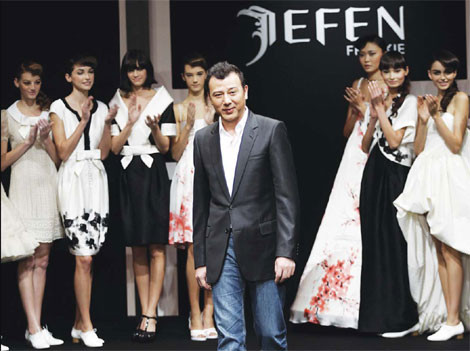Dressed for success
Updated: 2011-03-11 11:24
By Zhang Jing (China Daily European Weekly)
Chinese fashion guru says country is poised for the global catwalk
|
 Xie Feng, president of JEFEN, presented his designs at the runways of Paris Fashion Week in 2007. Provided to China Daily
|
"The best time has come for Chinese fashion designers to establish themselves in the world," says Xie Feng, president of Beijing-based JEFEN, a high-end fashion design company.
Xie is considered one of the top fashion designers in China and his customers include international movie star Zhang Ziyi. JEFEN's 300-plus employees helped reap a revenue of 300 million yuan (32.6 million euros) in 2010 and its branches in China have increased by 30 in one year to 70, one of which is located in Paris.
Xie was also the first Chinese fashion designer to be invited to present his designs at the runways of Paris Fashion Week in Carrousel du Louvre on Oct 1, 2006.
"This was a milestone for the Chinese fashion industry. Just like the American and Japanese designers who embarked on Paris runways in the 1960s and 70s, and changed the world's fashion trends, Xie's success means that China is on the road to becoming a leading country in fashion design," says Didier Grumbach, the French minister of culture and president of the French Fdration de la Couture, at a fashion week news conference.
"Previously, China needed to look up to the world leaders in fashion design such as Paris or New York, but now China will have her own say and her own style," Xie says.
"This is all decided by the demand of the market and consumers. As China is becoming stronger in terms of its economy and cultural influence, the fashion world will tailor to the taste of Chinese consumers. They will follow what Chinese like. For example, the color of red."
In Western culture, red often stands for "blood, danger or desire", but for Chinese, it means happiness and fortune.
JEFEN itself was registered in Italy in 2000.
"During the past 10 years, China has made great progress in terms of fashion design," Xie says. "But the greatest progress has been made by Chinese consumers, who have now become more self-confident and dare to express themselves by way of fashion.
"It would be unthinkable when you look back. At that time, Chinese would wear long woolen underwear and their pants could be loose enough to hold a pig.
"No wonder my daring design scared off many customers."
"But it was this setback that made me look real hard for what customers want and need in China," Xie says.
"A successful fashion designer should have a healthy dose of interest in one's own creativity, because the most important thing is to meet the demands of the market and consumers."
Xie has developed two brands: JEFEN and JEFEN By Frankie, both tailored for high-end women. The former targets 30- to 50-year-olds and the second label aims at 25- to 45-year-olds. Most of Xie's orders come from Beijing, Shenzhen and Shanghai.
Xie says his mission is to help those women "create a beautiful life". He is particular about every detail, from design to cloth. About 60 percent of his cloth is imported from abroad and 40 percent from the high-end domestic market.
"Cloth is a very important part of my design and forms part of our core competitiveness," Xie says.
"I can't afford to have a piece of cloth with low quality, which can degrade my design to a great extent," Xie says.
Many Peking University Executive MBA women students count themselves among his fans. One says that a JEFEN costume shows from every detail that the designer understands a woman's mentality.
A businessman even brought his daughter to a JEFEN store as soon as she came back from the UK for vacation.
"You have no idea how my mom adores JEFEN," says the young woman. "She would buy one dress only to discover she already had the same one when she opened her wardrobe."
Xie blends his consideration for the introverted personality of Chinese women into a European style in his designs.
"For a Chinese designer, it is important to understand the essence of Chinese culture and spirit, which is its profundity, its broadness and its tolerance of foreign culture," he says.
"Without this understanding, it will only be superficial to apply such Chinese elements as peonies and qipao to a costume."
E-paper

Pearl paradise
Dreams of a 'crazy' man turned out to be a real pearler for city
Literary beacon
Venice of china
Up to the mark
Specials

Power of profit
Western companies can learn from management practices of firms in emerging economies

Foreign-friendly skies
About a year ago, 48-year-old Roy Weinberg gave up his job with US Airways, moved to Shanghai and became a captain for China's Spring Airlines.

Plows, tough guys and real men
在这个时代,怎样才"够男人"? On the character "Man"
